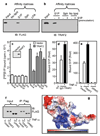Sphingosine-1-phosphate is a missing cofactor for the E3 ubiquitin ligase TRAF2
- PMID: 20577214
- PMCID: PMC2946785
- DOI: 10.1038/nature09128
Sphingosine-1-phosphate is a missing cofactor for the E3 ubiquitin ligase TRAF2
Abstract
Tumour-necrosis factor (TNF) receptor-associated factor 2 (TRAF2) is a key component in NF-kappaB signalling triggered by TNF-alpha. Genetic evidence indicates that TRAF2 is necessary for the polyubiquitination of receptor interacting protein 1 (RIP1) that then serves as a platform for recruitment and stimulation of IkappaB kinase, leading to activation of the transcription factor NF-kappaB. Although TRAF2 is a RING domain ubiquitin ligase, direct evidence that TRAF2 catalyses the ubiquitination of RIP1 is lacking. TRAF2 binds to sphingosine kinase 1 (SphK1), one of the isoenzymes that generates the pro-survival lipid mediator sphingosine-1-phosphate (S1P) inside cells. Here we show that SphK1 and the production of S1P is necessary for lysine-63-linked polyubiquitination of RIP1, phosphorylation of IkappaB kinase and IkappaBalpha, and IkappaBalpha degradation, leading to NF-kappaB activation. These responses were mediated by intracellular S1P independently of its cell surface G-protein-coupled receptors. S1P specifically binds to TRAF2 at the amino-terminal RING domain and stimulates its E3 ligase activity. S1P, but not dihydro-S1P, markedly increased recombinant TRAF2-catalysed lysine-63-linked, but not lysine-48-linked, polyubiquitination of RIP1 in vitro in the presence of the ubiquitin conjugating enzymes (E2) UbcH13 or UbcH5a. Our data show that TRAF2 is a novel intracellular target of S1P, and that S1P is the missing cofactor for TRAF2 E3 ubiquitin ligase activity, indicating a new paradigm for the regulation of lysine-63-linked polyubiquitination. These results also highlight the key role of SphK1 and its product S1P in TNF-alpha signalling and the canonical NF-kappaB activation pathway important in inflammatory, antiapoptotic and immune processes.
Figures




References
-
- Karin M, Gallagher E. TNFR signaling: ubiquitin-conjugated TRAFfic signals control stop-and-go for MAPK signaling complexes. Immunol. Rev. 2009;228:225–240. - PubMed
-
- Hayden MS, Ghosh S. Shared principles in NF-kappaB signaling. Cell. 2008;132:344–362. - PubMed
-
- Lee TH, Shank J, Cusson N, Kelliher MA. The kinase activity of Rip1 is not required for tumor necrosis factor-alpha-induced IkappaB kinase or p38 MAP kinase activation or for the ubiquitination of Rip1 by Traf2. J. Biol. Chem. 2004;279:33185–33191. - PubMed
-
- Xia P, et al. Sphingosine kinase interacts with TRAF2 and dissects tumor necrosis factor-alpha signaling. J. Biol. Chem. 2002;277:7996–8003. - PubMed
-
- Bhoj VG, Chen ZJ. Ubiquitylation in innate and adaptive immunity. Nature. 2009;458:430–437. - PubMed
Publication types
MeSH terms
Substances
Grants and funding
LinkOut - more resources
Full Text Sources
Other Literature Sources
Molecular Biology Databases
Research Materials
Miscellaneous

